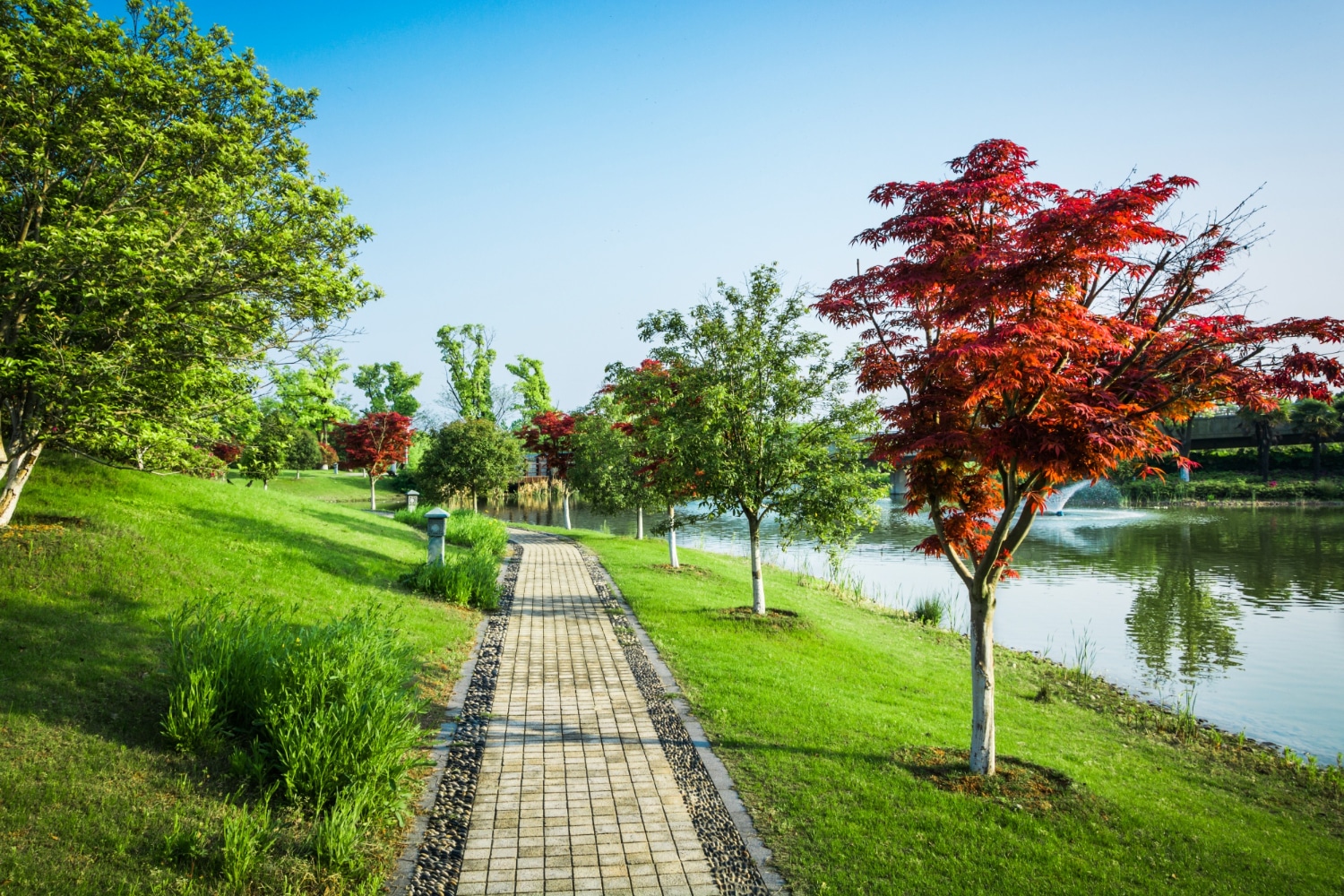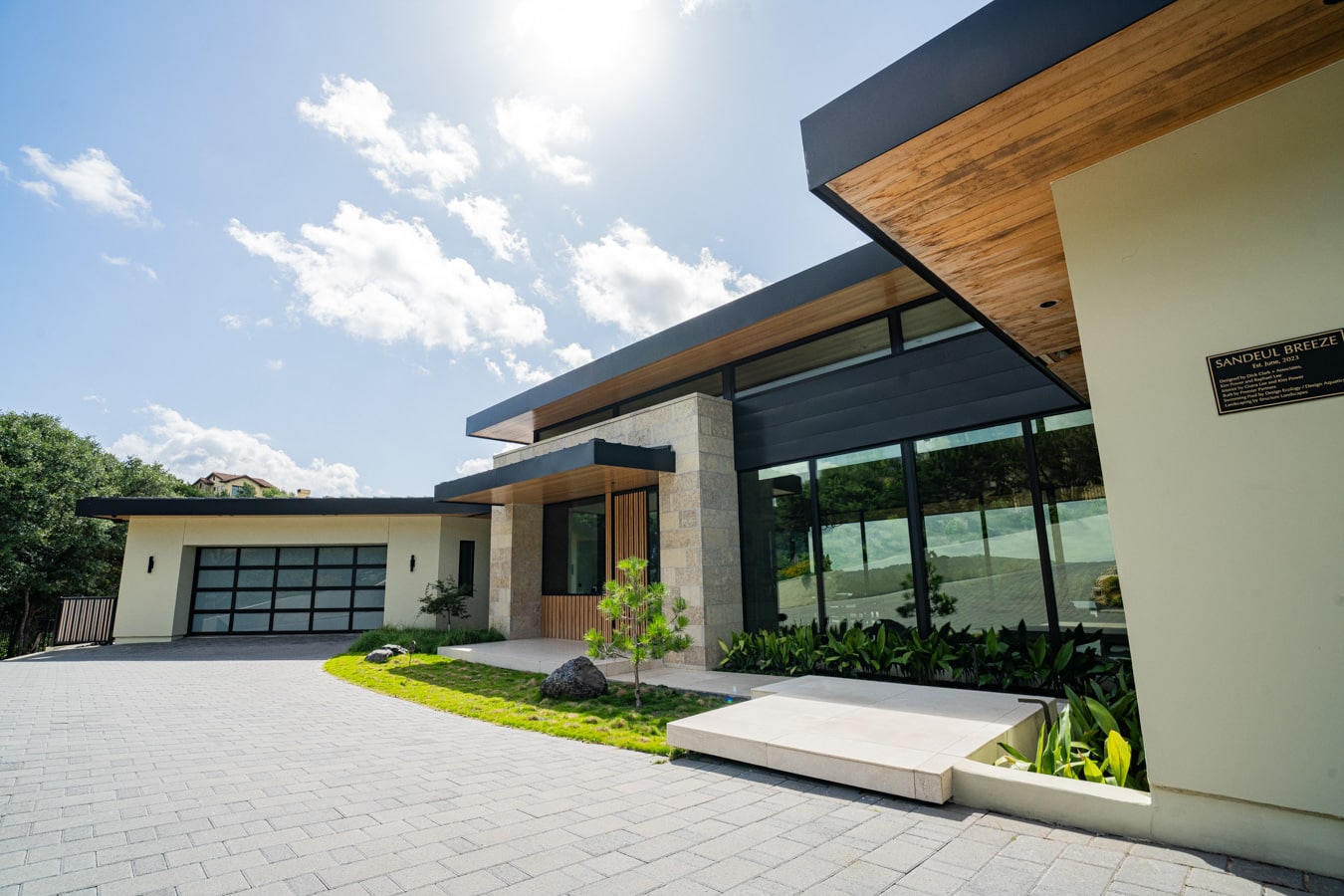Creating an eco-friendly landscape isn’t just good for the planet; it can save you time and money while creating a beautiful outdoor space that works with nature instead of against it. From using native plants that thrive in your local climate to implementing water-saving techniques like rain gardens, sustainable landscaping offers practical solutions for homeowners wanting to reduce their environmental impact.
By incorporating sustainable design principles into your yard, you can reduce water usage, minimize maintenance, decrease waste, and create a habitat for local wildlife all at once. These approaches represent a fundamental shift in how we think about our outdoor spaces. Rather than fighting against natural processes, sustainable landscapes work with them.
We’ve gathered some of the most effective eco-friendly landscape ideas that blend beauty with environmental responsibility. These designs range from simple weekend projects like installing rain barrels to more comprehensive approaches like replacing traditional lawns with native plant communities. Each solution offers a way to make your outdoor space more sustainable while creating a unique and attractive landscape.
Planning Your Eco-Friendly Landscape
Creating an eco-friendly landscape requires careful planning to ensure harmony with the local ecosystem while minimizing resource use. The right approach balances beauty with sustainability.
Understanding Eco-Friendly Concepts
Eco-friendly landscaping works with nature, not against it. This approach focuses on creating spaces that support local ecosystems while using fewer resources. The Sustainable Sites Initiative provides guidelines for landscape sustainability, and these principles help reduce water use, prevent soil erosion, and minimize waste generation.
Key concepts include:
- Water conservation: Using rainwater harvesting and efficient irrigation
- Reduced chemical use: Avoiding harmful pesticides and fertilizers
- Native plantings: Choosing plants adapted to your climate
- Biodiversity: Creating habitats for local wildlife
Assessing Your Landscape’s Potential
Before making changes, a thorough site assessment is needed to help identify opportunities and challenges. Start by mapping sun and shade patterns throughout the day, noting where water naturally collects or runs off after rain. Next, test your soil to determine its type and quality. This information guides plant selection and amendment needs.
Consider existing features worth preserving:
- Mature trees provide shade and wildlife habitat
- Natural drainage patterns can be enhanced
- Native plant communities may already exist
Reducing lawn size is one of the simplest eco-friendly changes. Large lawns require significant water, fertilizer, and maintenance, and you can replace portions with native plantings or functional garden spaces.
Selecting Sustainable Materials for Hardscape
Hardscape elements like patios, paths, and walls should be chosen with sustainability in mind. Consider permeable pavers for driveways and paths, as these allow rainwater to soak into the ground, reducing runoff and replenishing groundwater. Reclaimed materials like salvaged brick, stone, or wood add character while keeping items out of landfills. They often weather better than new materials, creating an established look from the start.
Look for these qualities in hardscape materials:
- Local sourcing: Materials from nearby locations reduce transportation impacts
- Permeability: Allowing water to filter through rather than run off
- Recycled content: Repurposed materials reduce resource extraction
- Durability: Long-lasting materials require less replacement
Plant Choices for Sustainability
Selecting the right plants is the foundation of any eco-friendly landscape design. Sustainable plant choices reduce maintenance needs, conserve water, and create habitats for local wildlife while adding beauty to our outdoor spaces.
Benefits of Using Native Plants
Native plants have evolved to thrive in local conditions, making them naturally adapted to regional soil, climate, and rainfall patterns. They typically require less water once established and fewer fertilizers or pesticides than non-native species.
They provide an essential habitat for local wildlife, including pollinators like bees and butterflies. Many birds, insects, and other animals also depend on specific native plants for food and shelter. Furthermore, native plant gardens can reduce maintenance time by up to 50% compared to conventional landscapes, saving both labor and resources.
Integrating Trees and Shrubs
Trees and shrubs form the backbone of sustainable landscapes, providing structure while delivering numerous environmental benefits. They capture carbon dioxide, filter air pollutants, and reduce energy costs by shading buildings in the summer.
Deciduous trees like oaks, maples, and sycamores offer summer shade but allow winter sunlight when they drop their leaves. This natural cycle helps regulate home temperatures year-round. Evergreen shrubs such as junipers and rhododendrons create windbreaks and privacy screens while staying green throughout the year.
Incorporating Perennials, Groundcovers, and Sedges
Perennials, groundcovers, and sedges complete sustainable landscapes by filling spaces between larger plants and adding diversity. These plants return year after year, eliminating the waste and expense of annual replanting. Groundcovers like creeping thyme and wild strawberries spread to cover bare soil, preventing weeds and erosion. They require minimal mowing and maintenance compared to traditional lawns.
Many groundcovers and perennials can handle foot traffic while using far less water than conventional turf grass. Sedges make excellent lawn alternatives for difficult areas. Pennsylvania sedge thrives in dry shade, while fox sedge handles wet conditions. These tough plants rarely need mowing or fertilizing.
Best Perennials for Pollinators:
- Butterfly weed
- Bee balm
- Goldenrod
- Blazing star
- Black-eyed Susan
Water Conservation Techniques
Water conservation is a key part of eco-friendly landscaping, and smart water use helps save money on utility bills and protects our natural resources.
Implementing Rainwater Harvesting Systems
Rainwater harvesting offers an excellent way to reduce dependence on municipal water sources. Rain barrels are the simplest option, collecting water from downspouts for later garden use. A standard 55-gallon barrel can capture significant runoff from even a small roof during moderate rainfall.
For larger properties, consider cistern systems that store hundreds or thousands of gallons underground or above ground. These systems can be connected to irrigation networks for automatic garden watering. Cost varies widely, from about $50 for DIY rain barrels to several thousand dollars for professional cistern installations.
Remember to install screens on collection points to keep out debris and mosquitoes. First-flush diverters are also valuable additions that prevent the initial, often dirty runoff from entering your storage system.
Creating Rain Gardens and Basins
Rain gardens are shallow depressions planted with native species that capture and filter stormwater. They prevent runoff and allow water to slowly seep into the ground, improving water quality and recharging groundwater supplies. The ideal location for a rain garden is at least 10 feet from your home’s foundation in a natural low spot. Size your garden to capture runoff from specific areas like downspouts or driveways.
Choose plants that can handle both wet and dry conditions. Native species like swamp milkweed, blue flag iris, and cardinal flower work well in many regions. Dry creek beds and swales serve similar purposes, directing water flow and preventing erosion while creating visual interest in the landscape.
Effective Yard Waste Management
Smart yard waste handling directly impacts water conservation. Composting leaves, grass clippings, and small branches creates valuable mulch that helps soil retain moisture. Apply a 2-3 inch layer of organic mulch around plants and trees to reduce evaporation and suppress weeds. This simple step can reduce water needs by up to 30% while slowly adding nutrients to the soil.
Consider grasscycling, which means leaving short grass clippings on the lawn rather than bagging them. This returns nutrients to the soil and helps retain moisture. Create brush piles in appropriate areas to catch runoff and prevent soil erosion on slopes. These piles also provide valuable wildlife habitats, adding biodiversity to your landscape. Also, avoid disposing of yard waste in waterways, as this can block drainage and introduce nutrients that harm water quality.
Maintaining Your Eco-Friendly Landscape
Proper maintenance ensures your sustainable landscape thrives while continuing to benefit the environment. Regular care using eco-friendly methods preserves both the beauty and ecological function of your outdoor space.
Organic Lawn Care Principles
Natural lawn care starts with choosing the right grass for your climate. Native grass varieties need less water and resist local pests better than non-native options. It’s best to mow at a higher setting (3-3.5 inches) to promote deeper root growth and natural weed suppression. For feeding your lawn, choose organic fertilizers made from plant or animal materials rather than synthetic chemicals.
Water deeply but infrequently to encourage strong root systems. Early morning watering (between 4-10 AM) reduces evaporation and fungal growth. Consider installing a rain sensor for your irrigation system to prevent unnecessary watering during rainy periods.
Managing Compacted Soil
Compacted soil prevents proper root growth and water absorption, so test for compaction by pushing a screwdriver into your soil – if there’s a lot of resistance, you likely have compaction issues. Core aeration is the most effective solution. This process removes small plugs of soil, allowing air, water, and nutrients to penetrate deeper.
Aerate your soil yearly, ideally in fall for cool-season grasses or late spring for warm-season varieties. You should also avoid walking on wet soil, which increases compaction; instead, create designated pathways through garden areas to minimize soil pressure in planting beds.
Soil Amendment Options:
- Compost (improves structure and adds nutrients)
- Worm castings (enhances microbial activity)
- Organic matter (increases water retention)
Eco-Friendly Landscaping Techniques
Install drip irrigation systems that deliver water directly to plant roots and group plants with similar water needs together, a practice called hydrozoning. Prune selectively and only when necessary. Dead or diseased branches should be removed promptly, but avoid excessive trimming, which can stress plants and reduce wildlife habitat.
Additionally, practice integrated pest management (IPM) instead of using chemical pesticides. This approach emphasizes:
- Regular monitoring for pest issues
- Using physical barriers like row covers
- Introducing beneficial insects
- Applying organic deterrents as a last resort
Get in touch to discuss the best options for creating an eco-friendly garden.





